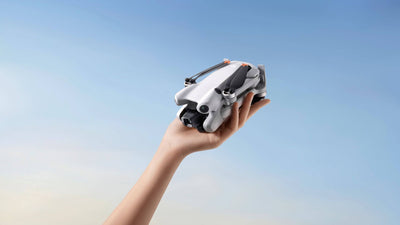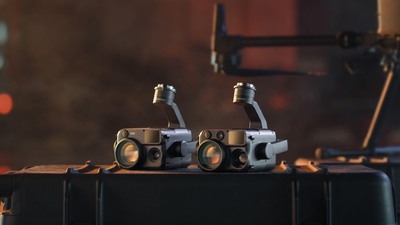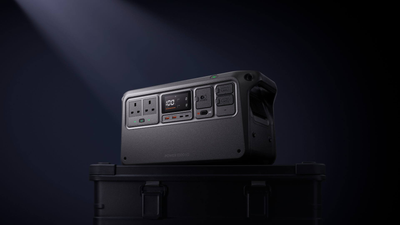Drone Range Explained: How Far Can You Really Fly?
- by Stefan Gandhi
Drone technology has come a long way. Once a niche gadget, drones are now essential tools for content creators, surveyors, public safety teams and hobbyists alike. But no matter how sleek the design or powerful the camera, one question continues to shape how people fly: how far can a drone really go?
Understanding drone range is about more than just reading the spec sheet. In real-world use, there are technical, environmental and legal boundaries that define how far you can fly safely and effectively. This guide breaks down what truly affects drone range for both consumers and professionals in the UK.
What Drone Range Really Means
Drone range is typically described in two ways, control range and flight range.
- Control range is the maximum distance at which your remote controller can communicate with your drone. This is governed by the strength of the radio link, interference in the environment and the type of antenna system used.
- Flight range is how far your drone can physically travel, limited by battery life, speed, wind resistance and return-home requirements.
These two elements often overlap but they can diverge dramatically depending on how and where you're flying.
Factors That Affect Drone Range
Battery Performance
Battery capacity plays a major role in determining your drone's true travel distance. High-capacity batteries theoretically allow for longer flights, but actual mileage varies. Wind, manoeuvres, camera usage and payload weight can all eat into battery life. A round-trip flight needs to include enough charge to return safely, not just reach a distant point.
Signal Interference
Urban environments with buildings, trees and electrical noise can drastically reduce control range. Even in open fields, other radio signals from nearby devices or mobile towers can disrupt your connection. Once a signal drops, most drones will automatically attempt to return home, but this only works if they have enough power and a clear flight path back.
Weather Conditions
Wind, rain, temperature and even humidity influence how far and how efficiently your drone can fly. Strong headwinds require more energy to fight against. Cold weather reduces battery performance. Even minor gusts can force drones to compensate constantly, using up power faster.
Drone Design & Payload
Compact consumer drones tend to prioritise portability over range, while professional models often feature high-gain antennas and more efficient motors. Adding a camera gimbal, sensors or other payloads can weigh down the drone and increase drag, decreasing both battery life and speed.
Altitude & Terrain
Flying at higher altitudes or over rugged terrain creates new risks. Maintaining visual line of sight becomes more difficult, and GPS or return-home features may be affected by elevation changes or signal drops. These environmental factors directly reduce how far you can confidently fly.
Line of Sight & Legal Limits
In the UK, drone operators must always keep their aircraft within visual line of sight. This rule, along with altitude restrictions and airspace limitations, significantly reduces the maximum legal range. Even if your drone can technically fly several kilometres, flying beyond your visual range without special permissions is not permitted.
Real-World Range Expectations
Manufacturers often list control ranges of 5 to 15 kilometres on their products. In practice, UK drone operators typically experience much lower effective ranges:
- Entry-level consumer drones may have a usable range of 500 to 1000 metres in clear conditions.
- Mid-tier drones could reach 2 to 4 kilometres in open space, though urban interference may reduce that.
- Professional drones built for inspection, mapping or emergency response may fly beyond 5 kilometres with proper authorisation and line of sight.
However, it's not just about how far a drone can fly. It's about how far it can fly safely, predictably and within the law.
How To Maximise Your Drone’s Effective Range
To get the best performance from your drone, consider these practical steps:
- Launch from elevated, obstruction-free areas
- Avoid interference-heavy environments such as city centres or industrial zones
- Fly in calm weather with minimal wind
- Reduce payload weight when maximum range is needed
- Regularly check and maintain firmware and battery health
- Always fly with a return buffer of at least 25 to 30 percent battery
- Plan routes that maintain a safe path for return-home functions
Audience-Specific Considerations
For Creative Hobbyists
Focus on drones with stable video transmission and strong GPS lock. You don’t need to fly miles to capture stunning footage. What matters is signal reliability and easy handling.
For Professional Users
Look for systems with long-range antennas, smart mission planning tools and extended flight times. Always prioritise compliance and safety over pushing technical limits.
For Outdoor Adventurers
Portability matters, but so does battery capacity and wind resistance. A rugged design with solid range and smart return functions will keep you safe in remote areas.
For Family or Gift Buyers
Ease of use and safety features are more important than extended range. Look for drones with clear range limits, low-altitude settings and obstacle avoidance.
For Drone Racers
Your range needs are short and sharp. Focus on latency, acceleration and responsiveness rather than distance.
For Travel Enthusiasts
Pick a compact, foldable drone with solid mid-range performance. You want portability combined with the ability to capture sweeping travel shots without fuss.
For High-Investment Hobbyists
You want premium build quality, advanced range and longer flight times. Consider drones with dual frequency transmission and advanced navigation features.
For Law-Conscious Operators
Range is irrelevant if the flight breaks regulations. Stay within line of sight, avoid restricted airspace and respect privacy and safety rules.
FAQs
How far can a drone legally fly in the UK?
As far as you can maintain direct visual line of sight, usually no more than 500 to 700 metres for most people.
Why does my drone lose signal before reaching its advertised range?
Real-world interference, terrain and environmental factors all reduce effective range compared to manufacturer estimates.
Does flying higher increase range?
Not necessarily. Flying higher can help signal strength in open areas but may breach altitude limits and make visual line of sight difficult.
What happens if my drone flies out of range?
Most drones will initiate automatic return-to-home if the signal drops. However, this relies on GPS accuracy and sufficient battery.
Can I increase my drone’s range with accessories?
Yes, range extenders and signal boosters exist, but they don’t override legal limits or compensate for all interference factors.
Conclusion
Drone range is as much about practical strategy as it is about specs. While some drones can technically travel for kilometres, the real question is how far they can fly with control, safety and legal compliance. Whether you're creating cinematic landscapes, inspecting infrastructure or just exploring the skies, your drone's range depends on smart planning, environment awareness and responsible flying.
Ready to take your drone flights further? Explore long-range drones, accessories, training courses and more at the Coptrz official online store.




